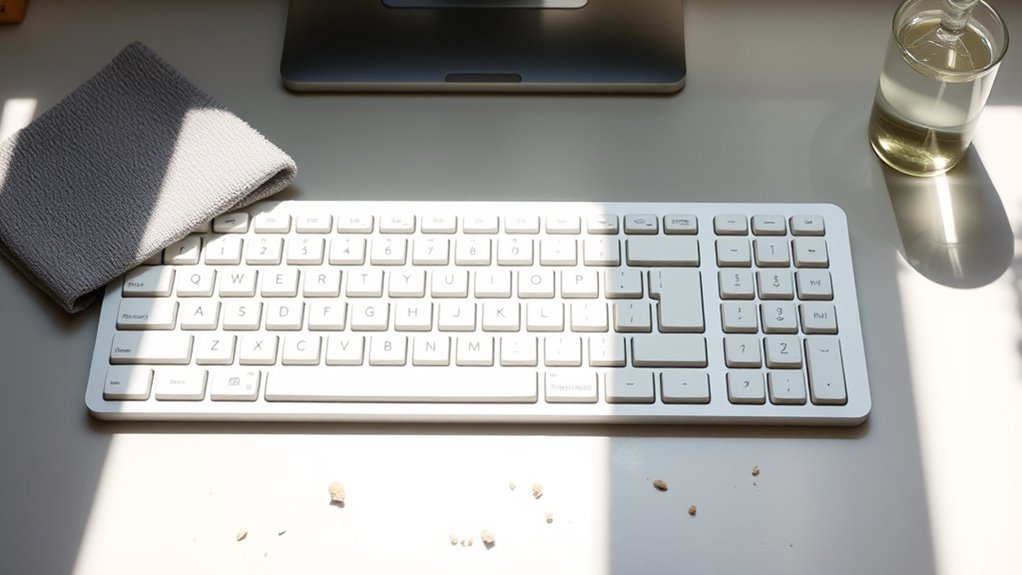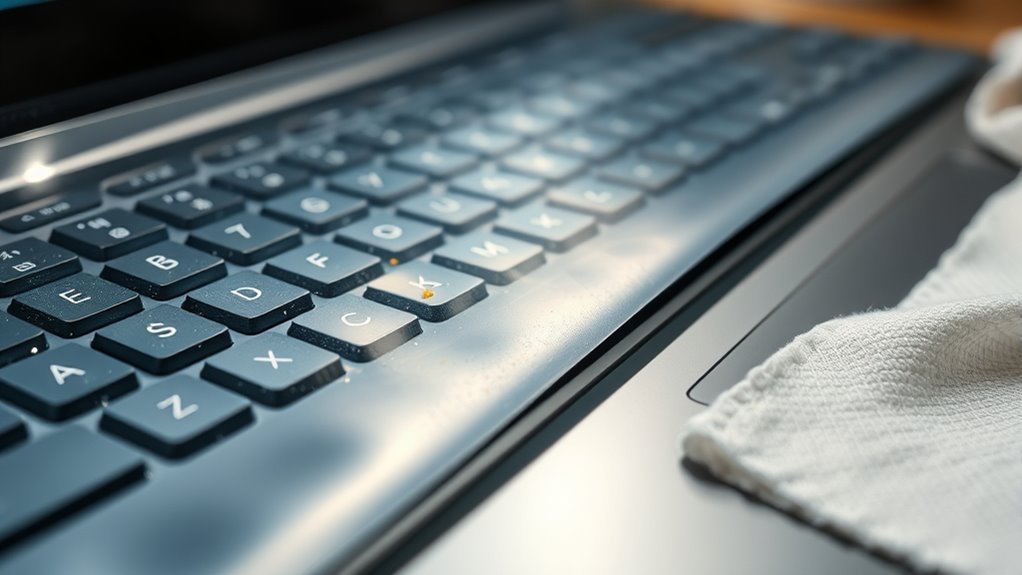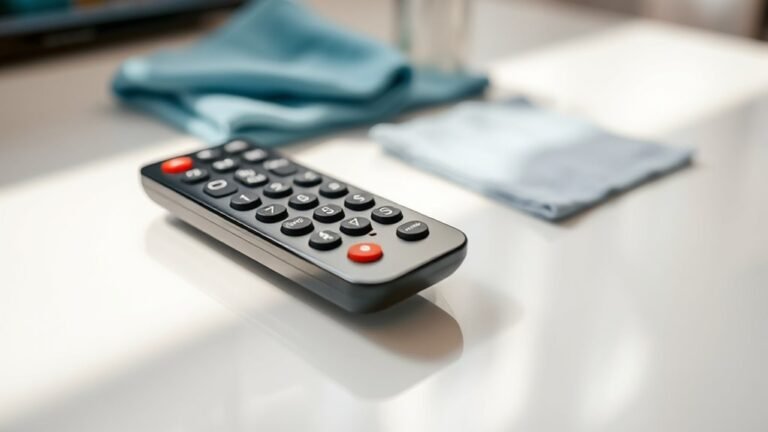Preventing Dirt Buildup on Keyboard
To prevent dirt buildup on your keyboard, regularly clean it using compressed air and a microfiber cloth, ideally weekly if used heavily. Use a silicone keyboard cover to block dust and oils while maintaining touch sensitivity. Always wash your hands before typing and avoid eating or drinking nearby to reduce crumbs and spills. Store your keyboard properly on a clean surface and use dust covers when not in use. Following these steps will help you maintain a cleaner, longer-lasting keyboard—there’s more you can do to optimize upkeep.
Regular Cleaning Routine for Your Keyboard

Although it might seem tedious, establishing a regular cleaning routine for your keyboard is crucial to prevent dirt buildup and maintain peak functionality. You should set a cleaning frequency based on your usage—weekly for heavy use, biweekly for moderate. Use appropriate cleaning tools: a soft microfiber cloth, compressed air canisters, and gentle isopropyl alcohol wipes. Avoid harsh chemicals that can damage key surfaces. Begin by disconnecting your keyboard, then use compressed air to dislodge debris between keys. Follow with a lightly dampened cloth to remove surface grime. Consistent adherence to this routine guarantees your keyboard remains responsive and hygienic, granting you freedom from malfunction and prolonged device lifespan without sacrificing productivity. This disciplined approach streamlines maintenance and preserves your keyboard’s performance efficiently.
Using Keyboard Covers and Protectors
When you want to minimize dirt buildup without constant cleaning, using keyboard covers and protectors offers an effective barrier against dust, crumbs, and spills. These covers, often made from silicone or TPU, conform to your keyboard materials, maintaining tactile responsiveness while shielding surfaces. The cover benefits include preventing particles from settling between keys and reducing exposure to oils from your fingers. They’re easy to install and remove, letting you maintain hygiene without restricting your workflow. Additionally, they protect against accidental liquid damage, extending your keyboard’s lifespan. Choosing a cover designed specifically for your keyboard model guarantees ideal fit and preserves key legends’ visibility. By incorporating keyboard covers into your routine, you gain freedom from frequent deep cleans and protect your device with minimal effort.
Best Practices for Hand Hygiene

Maintaining clean hands is one of the simplest yet most effective ways to prevent dirt buildup on your keyboard. Prioritize regular hand washing with soap and warm water for at least 20 seconds, especially before using your keyboard. This removes oils, dead skin cells, and contaminants that transfer to the keys. When hand washing isn’t feasible, use sanitizing wipes to quickly disinfect your hands without leaving residue. Choose wipes free of harsh chemicals that could irritate your skin or leave sticky deposits on the keyboard. Consistent hand hygiene reduces grime accumulation and extends your keyboard’s lifespan. By committing to these best practices, you maintain a cleaner workspace and enjoy greater freedom from frequent, intensive keyboard cleaning sessions.
Avoiding Eating and Drinking Near Your Keyboard
Keeping your hands clean helps reduce dirt buildup, but controlling what you bring near your keyboard is equally important. Eating or drinking at your workstation introduces crumbs and spills that attract dust and grime, accelerating keyboard degradation. To maintain ideal cleanliness, consider these practical strategies:
- Opt for snack alternatives like whole fruits or bite-sized vegetables that shed less residue.
- Choose drink choices with secure lids to minimize spill risks.
- Use designated eating areas away from your keyboard to physically separate food and tech.
- Regularly clean your keyboard if accidental spills or crumbs occur.
- Employ keyboard covers for added protection during unavoidable snacking.
Proper Storage and Handling Techniques

To extend your keyboard’s lifespan, proper storage and handling are essential. Start by ensuring ideal keyboard placement—keep it on a clean, flat surface away from direct sunlight and excessive dust. Avoid placing it near vents or open windows where particles accumulate. When not in use, utilize effective storage solutions like dust covers or dedicated keyboard cases to shield it from dirt and debris. Handle your keyboard with clean hands to prevent oil and grime transfer. If you need to transport it, secure it in a padded case to avoid damage and contamination. Regularly inspect your storage environment to maintain cleanliness. Adopting these precise practices grants you the freedom to work efficiently without worrying about dirt buildup compromising your keyboard’s performance or longevity.
Frequently Asked Questions
Can Air Dusters Damage My Keyboard Keys?
Think of using an air duster like wielding a powerful leaf blower in a delicate flower garden—it’s effective but needs care. You shouldn’t use air dusters too close or at odd angles, as excessive pressure can loosen or damage keyboard keys. For ideal air duster safety, hold the can upright and spray short bursts. This maintains keyboard maintenance without risk, giving you freedom to clean powerfully yet safely.
How Often Should I Replace My Keyboard Cover?
You should replace your keyboard cover every 6 to 12 months, depending on wear and tear. For ideal keyboard maintenance tips, inspect the cover regularly for cracks, discoloration, or loss of flexibility. Following cover lifespan recommendations guarantees your keyboard stays protected and responsive. If you notice reduced fit or hygiene concerns, swapping it out promptly maintains performance and cleanliness, giving you the freedom to work without distractions or damage.
Are Silicone Keyboard Protectors Better Than Plastic Ones?
Back in the days of the telegraph, you’d appreciate efficiency, and silicone keyboard protectors deliver just that. They offer superior flexibility, durability, and better resistance to oils and dirt compared to plastic. Silicone benefits include a snug fit and easy cleaning, while plastic drawbacks often involve cracking and less effective protection. If you want freedom from frequent replacements and a reliable shield, silicone’s your best bet—combining toughness with comfort for everyday use.
Can UV Light Sanitize My Keyboard Effectively?
You can rely on UV effectiveness to sanitize your keyboard efficiently, as UV-C light disrupts microbial DNA, killing bacteria and viruses. However, be mindful of keyboard safety—prolonged UV exposure may degrade plastic components or damage electronic circuits. To maintain your freedom from germs without harming your device, use a UV sanitizer designed for electronics, follow manufacturer’s guidelines, and limit exposure time to balance sanitation with preserving your keyboard’s longevity.
Does Humidity Affect Keyboard Dirt Buildup?
Think of humidity effects like the steam engines of old, quietly influencing everything nearby. When humidity’s high, moisture attracts dust and grime, accelerating dirt buildup on your keyboard. For effective keyboard maintenance, keep your workspace dry and use silica gel packs or a dehumidifier. This helps preserve your device’s freedom from debris and guarantees smooth functionality, letting you work without the chains of constant cleaning interruptions.






